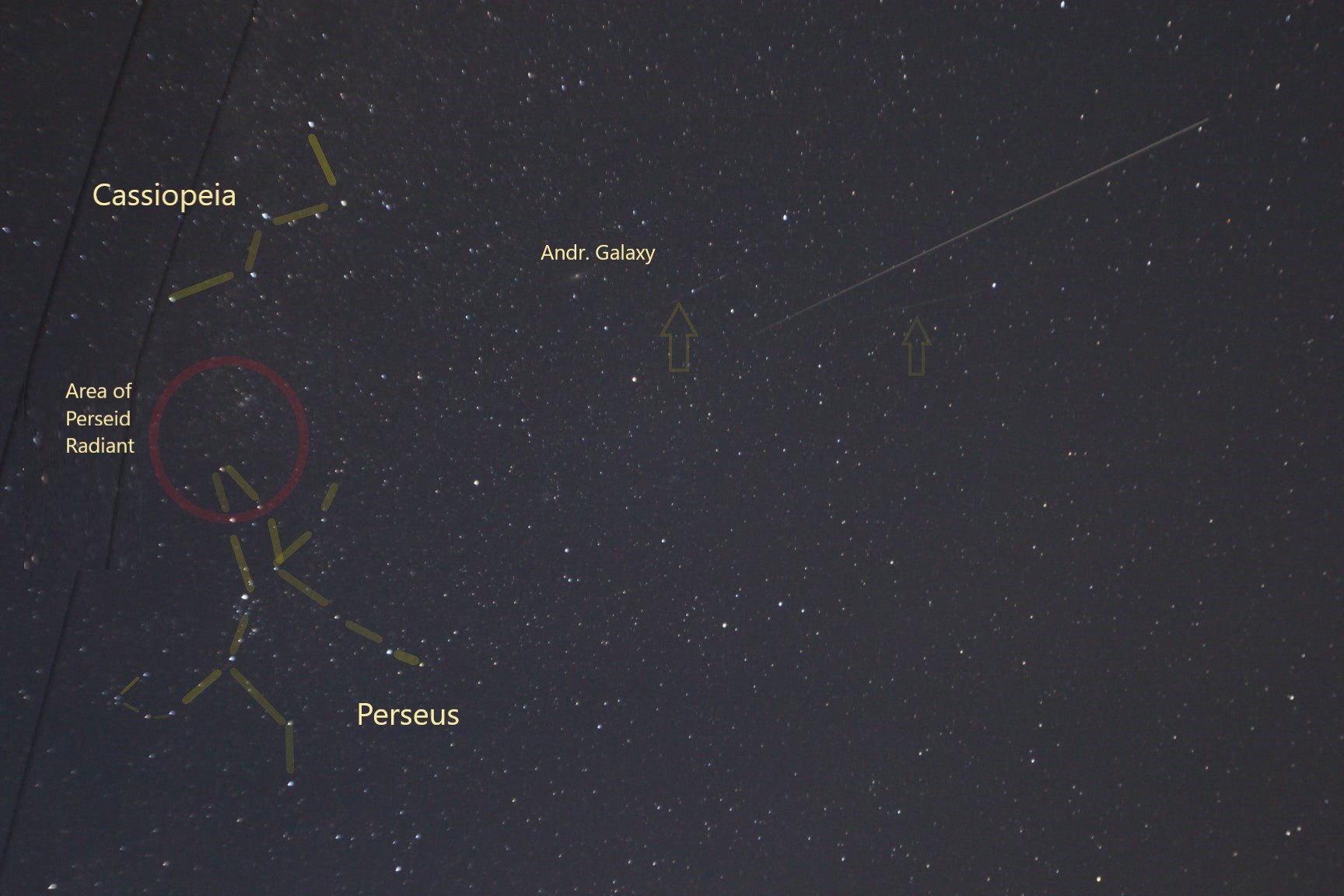PEACHY PERSEID PROSPECTUS
The annual peak of the Perseid meteor shower is one of the big moments for stargazing with the unaided eye. In some years, such as 2020 (when everything seemed to be bad) or 2022, the event can be largely ruined by bright moonlight, with only the brightest meteors peeking through the glare. However, 2023 is excellent from the moonlight standpoint, as a thin waning crescent that rises before dawn will be pretty to look at but pose little or no interference. Also, the maximum takes place on a weekend this year- better for most people, although not necessarily Park Rangers!
The Perseids come from small bits of debris left behind by Comet Swift-Tuttle, which last appeared in 1992 and will return in 2126. Each year, when the Earth intersects the comet’s orbit, some of the debris collides with Earth’s atmosphere and burns up, producing the characteristic streak of light across the sky. Enhanced activity occurs when the parent comet is itself nearby, which won’t be the case for a long time, but there is plenty of debris distributed along Swift-Tuttle’s orbit due to the comet’s multiple passes around the Sun. The Perseids rival the Geminids as the richest of all the meteor showers, and of course are by far the most viewed due to the latter peaking in the middle of December each year.
Of course, I go out to see the Perseids in any year where the moon prospects are favorable and the weather forecast is good. I have seen as many as 50 meteors per hour myself, when I have traveled out to a dark sky location. Some of my friends, from even better locations and with better eyes than mine, have seen close to 100 meteors per hour. City lights will blot out the large majority of the meteors, but if you can’t travel, you should be able to see at least a few meteors per hour if you follow my suggestions here.
The best time to look will be between midnight and dawn on the night of August 12-13. If that night doesn’t work for you or if the weather forecast is bad, there will be fewer but possibly still worthwhile numbers of meteors visible for a couple of nights on either side of the maximum. I know that this timing is inconvenient for most people, but it can’t be helped- it is due to the radiant point of the meteors being low in the sky during the evening hours. If you can’t stay up late, even though the shower is on a weekend this year, you will probably see a few meteors during the late evening hours before you go to bed.
Find a dark sky site, or at least a spot that doesn’t have lights shining down on you, and look up towards the darkest part of the sky, usually high up in the east or overhead. If you spot a meteor, mentally draw a line back to the point where it appeared to come from in the sky. More than likely, this will appear to be just east of the “W” of stars that forms the constellation Cassiopeia. An occasional meteor might appear to come from a different direction, in which case it is from one of the other minor meteor showers underway this year, or a random “sporadic.” The stars in this area form the constellation Perseus, famous in Greek mythology for slaying the Medusa and for rescuing the princess Andromeda. It is best to look not actually at the radiant point, but a few fists at arm’s length away from it. Since you will staying in one place for quite a while, it is best to bring a sleeping bag, blanket, or lawn chair to lay down on, as well as a sweater or jacket, as temperatures drop overnight. Another necessity is bug spray, as you will be a sitting duck for mosquitoes.
If you have a DSLR type camera and can put it on a tripod, you can take time exposures of 30 seconds-1 minute, and hope to catch a meteor or two in a picture, if you take enough shots and are lucky. Have your camera lens wide open, your settings to manual, and set your ISO speed to fast, maybe 2000 or so. You may need to adjust your ISO and exposure settings depending upon how much glare you get from city lights. I took the picture below during the 2021 shower (the last moon-free one) and it actually shows three meteors in one shot if you look closely, although two are dim. If you get a successful observation or image of the Perseids, feel free to e-mail me at the address below.
While you are out late watching the Perseids, you will not fail to notice bright Jupiter, in the eastern sky, and Saturn, in the southwest after midnight. These planets will gradually make their way into more convenient evening skies, which I will discuss in future editions of this blog.

Three Perseids as seen from Okawville, IL on the morning of August 12, 2021, about 2 am. Notice how the streaks come from a point below the “W” of Cassiopeia, at the left of the picture.
Join us for the annual Kids Explorer Night at the Gateway Arch at 7 pm on Friday, August 25. Children between 5-12 can earn a Junior Ranger Night Explorer patch that is customized to our Park. RSVP by e-mailing richard_fefferman@nps.gov or calling 314-655-1704. The program will be held in Tucker Theater in the Gateway Arch Visitor Center, and weather permitting, will be followed by free telescope viewing on our Entrance Plaza, led by the Park and volunteers from our partners with the St. Louis Astronomical Society.
